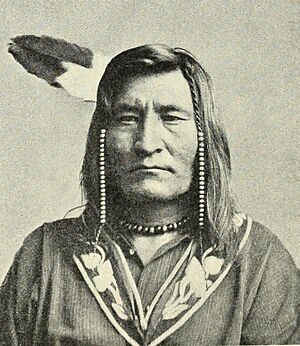Thomas Little Shell facts for kids
Thomas Little Shell III (born around 1830, died 1901) was an important leader of a group of the Ojibwe people. His Ojibwe name was Esens, which means "Little Shell" or "Little Clam." He led his people in the late 1800s. At that time, the Ojibwe, also known as Anishinaabeg, lived across a huge area. This land stretched from southwestern Canada into the northern United States, including areas like the Dakotas and Montana.
Contents
Protecting Ojibwe Lands
Little Shell was a strong leader who worked to protect his people's land. He spent many years negotiating with the United States government. These talks were about the Ojibwe's traditional lands.
Early Land Talks (1850s to 1870s)
In the 1850s, the United States government started talking with the Anishinaabeg in North Dakota. They wanted the Ojibwe to give up their land. In return, the government offered money and a place to live on a special reservation.
Long before this, perhaps in the 1700s, the Anishinaabeg had moved into the Great Plains. This move was partly because European and American settlers were moving into their original lands around the Great Lakes. By the time settlers arrived in areas like Pembina and Saulteaux lands, the Ojibwe territory reached into Alberta, Canada, and much of present-day Montana.
Little Shell signed the 1863 Treaty of Old Crossing. This treaty meant the Ojibwe gave up land in Minnesota and North Dakota. However, in 1864, he refused to talk further with the United States about giving up more land. For nearly 30 years after that, Little Shell continued to refuse more land negotiations. The Anishinaabeg held onto a vast area, over 63 million acres (about 255,000 square kilometers). Much of this land was in North and South Dakota. It also included land in Montana, possibly reaching the Rocky Mountains.
Later Land Talks (1880 to 1901)
Around 1880, Little Shell moved his group from southern Canada. They settled in the Turtle Mountains in north-central North Dakota. Here, he protested against American settlers moving onto Ojibwe land. He also spoke out about the government's lack of care for Ojibwe land rights.
Because there wasn't enough food, Little Shell and his people hunted buffalo far away. They traveled to Montana and southern Saskatchewan in the late 1880s. When they came back to the Turtle Mountains in the early 1890s, they faced new challenges. These events eventually led to Little Shell's group and other Ojibwe people being forced to leave the Dakotas.
In 1892, Little Shell met with American representatives again. He tried to make an agreement about the remaining Ojibwe land. Many European-American settlers were already living on Native American lands in Montana, North Dakota, and South Dakota without waiting for treaties.
Little Shell wanted to sell his remaining lands for $1.00 per acre. He also wanted 10 million acres (about 40,000 square kilometers) in Montana, North Dakota, and South Dakota to be set aside as a reservation. The Americans offered only 10 cents an acre. This offer became known as the "Ten-Cent Treaty." They also refused to set aside the 10 million-acre reservation. No agreement was reached with Little Shell. Instead, the United States agent brought in 32 other Ojibwe leaders who signed the treaty.
Little Shell's lands in Montana started at the Missouri River on the Montana-North Dakota border. They followed the Yellowstone River to its source. These lands likely included the Big Belt Mountains and Little Belt Mountains. They may have even reached the Rocky Mountains near Augusta. The Ojibwe on the plains shared their Montana lands with the Assiniboine and probably the Gros Ventre peoples.
See also


